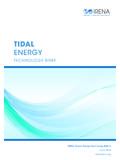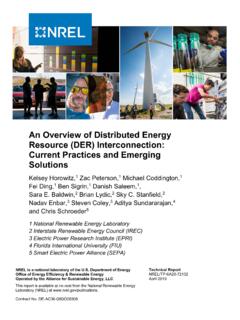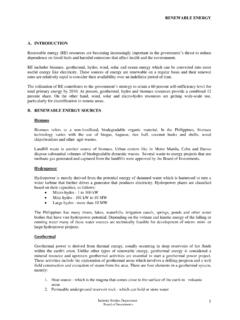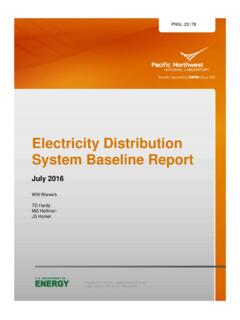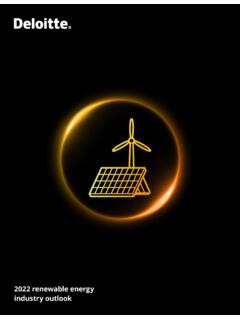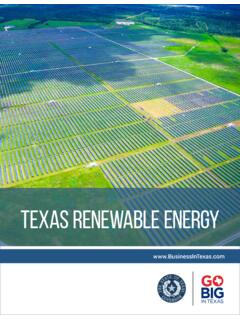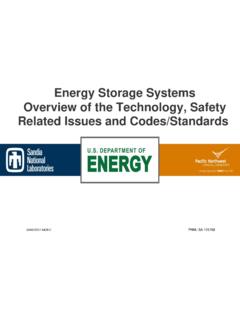Transcription of Renewable Energy Integration in Power Grids
1 Renewable Energy Integration in Power GridsTechnology BriefIEA-ETSAP and IRENA Technology Brief E15 April Renewable Energy AgencyIRENAENERGY TECHNOLOGY SYSTEMS ANALYSIS PROGRAMMEThis brief is available for download from the following IEA-ETSAP and IRENA IEA-ETSAP and IRENA 2015 About IRENAThe International Renewable Energy Agency (IRENA) is an intergovernmental organisation that supports countries in their transition to a sustainable Energy future, and serves as the principal platform for international cooperation, a centre of excellence, and a repository of policy, technology, resource and financial knowledge on Renewable Energy . IRENA promotes the widespread adoption and sustainable use of all forms of Renewable Energy , including bioenergy, geothermal, hydropower, ocean, solar and wind Energy , in the pursuit of sustainable development, Energy access, Energy security and low-carbon economic growth and IEA-ETSAPThe Energy Technology Systems Analysis Programme (ETSAP) is an Implementing Agreement of the International Energy Agency (IEA), first established in 1976.
2 It functions as a consortium of member country teams and invited teams that actively cooperate to establish, maintain, and expand a consistent multi-country Energy /economy/environment/engineering (4E) analytical backbone consists of individual national teams in nearly 70 countries, and a common, comparable and combinable methodology, mainly based on the MARKAL / TIMES family of models, permitting the compilation of long term Energy scenarios and in-depth national, multi-country, and global Energy and environmental promotes and supports the application of technical economic tools at the global, regional, national and local levels. It aims at preparing sustainable strategies for economic development, Energy security, climate change mitigation and holds open workshops twice a year, to discuss methodologies, disseminate results, and provide opportunities for new users to get acquainted with advanced Energy -technologies, systems and modeling Energy Integration in Power Grids | Technology Brief1 Insights for Policy MakersThe share of renewables in overall Power generation is rapidly increasing, both in developed and developing countries.
3 Furthermore, many countries have am-bitious targets to transform their Power sector towards renewables. To achieve these objectives, the structure and operation of existing Power grid infrastructures will need to be revisited as the share of Renewable Power generation increases. Renewable Energy technologies can be divided into two categories: dispatch-able ( biomass, concentrated solar Power with storage, geothermal Power and hydro) and non-dispatchable, also known as Variable Renewable Energy or VRE ( ocean Power , solar photovoltaics and wind). VRE has four characteristics that require specific measures to integrate these technologies into current Power sys-tems: 1) variability due to the temporal availability of resources; 2) uncertainty due to unexpected changes in resource availability; 3) location-specific properties due to the geographical availability of resources; and 4) low marginal costs since the resources are freely transition towards high shares of VRE requires a re-thinking of the design, operation and planning of future Power systems from a technical and economic point of view.
4 In such a system, supply and demand will be matched in a much more concerted and flexible way. From a technical perspective, VRE generation can be ideally combined with smart grid technologies, Energy storage and more flexible generation technologies. From an economic perspective, the regulatory framework will need to be adjusted to account for the cost structure of VRE in-tegration, to allow for new services and revenue channels, and to support new business are several technological options that can help to integrate VRE into the Power system grid: system-friendly VREs, flexible generation, grid extension, smart grid technologies, and storage technologies.
5 New advances in wind and solar PV technologies allow them to be used over a wider range of conditions and provide ancillary services like frequency and voltage control. Flexible generation requires changes in the Energy mix to optimise production from both dispatchable and non-dispatchable resources. Smart grid technologies can act as an enabler for VRE Integration , given their ability to reduce the variability in the system by allow-ing the Integration of renewables into diverse electricity resources, including load control ( Demand Side Management (DSM), Advanced Metering Infrastructure (AMI), and enhancing the grid operation and therefore helping to efficiently man-age the system s variability by implementing advanced technologies ( smart inverters, Phasor Measurement Unit (PMU) and Fault Ride Through (FRT) capa-bilities).)
6 Energy storage technologies can alleviate short-term variability (up to Renewable Energy Integration in Power Grids | Technology Brief2several hours), or longer-term variability through pumped-storage hydroelectric-ity, thermal Energy storage or the conversion of electricity into hydrogen or gas. Two immediate applications for deploying innovative technologies and operation modes for VRE Integration are mini- Grids and island systems. The high costs for Power generation in these markets make VREs and grid Integration technologies economically attractive since they can simultaneously improve the reliability, ef-ficiency and performance of these Power systems. This is, for example, the case of the Smart Grid demonstration project in Jeju Island, South , the right assessment and understanding of VRE Integration costs are relevant for policy making and system planning.
7 Any economic analysis of the transition towards renewables-based Power systems should, therefore, consider all different cost components for VRE grid Integration , such as grid costs ( expansion and upgrading), capacity costs and balancing costs. Integration costs are due not only to the specific characteristics of VRE technologies but also to the Power system and its adaptability to greater variability. Therefore, these costs should be carefully interpreted and not entirely attributed to VRE, especially when the system is not flexible enough to deal with variability ( in the short-term). Moreover, RE Integration delivers broader benefits beyond purely economic ones, such as social and environmental benefits.
8 Even though not straightforward, these externalities should be considered and quantified in order to integrate them into the decision-making process and maximise socio-economic to the rapid technological progress and multiple grid Integration options available, policy makers should build a framework for RE grid Integration based on the current characteristic of the system, developing technological opportunities and long-term impacts and targets. In particular, policy makers should adopt a long-term vision for their transition towards renewables and set regulatory frame-works and market designs to foster both RE development and management of greater system variability.
9 Such regulatory frameworks could include new markets for ancillary services and price signals for RE Power generators that incentivise the reduction of Integration Energy Integration in Power Grids | Technology Brief3 HIGHLIGHTS nProcess and Technology Status Since 2011, renewables have accounted for more than half of all capacity additions in the Power sector. Renewable Energy (RE) technologies for electricity generation can be grouped into dispatchable renewables ( hydro, geothermal and biomass Power ), which are basically ready for production upon demand, and non-dispatchable or variable renewables ( wind and solar), whose electricity production depends upon meteorological conditions and/or the time of the day.
10 This brief deals with the Integration of non-dispatchable Renewable Power technologies primarily wind and solar Power into the Power Grids . The typical modular size of variable Renewable technologies is well suited to distributed Power generation systems in which a number of small Power plants are connected to the distribution grid and produce electricity close to the demand site. However, the connection of variable renewables to the dis-tribution Grids requires that several factors be considered, such as the impact on slow voltage variations, the Power plants behavior under faulted1 conditions and their interaction with protection systems. The Integration of a significant amount of variable renewables into Power Grids requires substantial transformations to increase the flexibility of the existing Grids : a) to allow electricity flow, not only from centralised Power plants to users, but also from small users/producers to the grid, which is aimed to ensure grid stability when installing distributed generation; b) to establish intelligent grid and demand management mechanisms aimed at increasing flexibility and responsiveness and reducing peak-loads in order to deal with increased variability.


